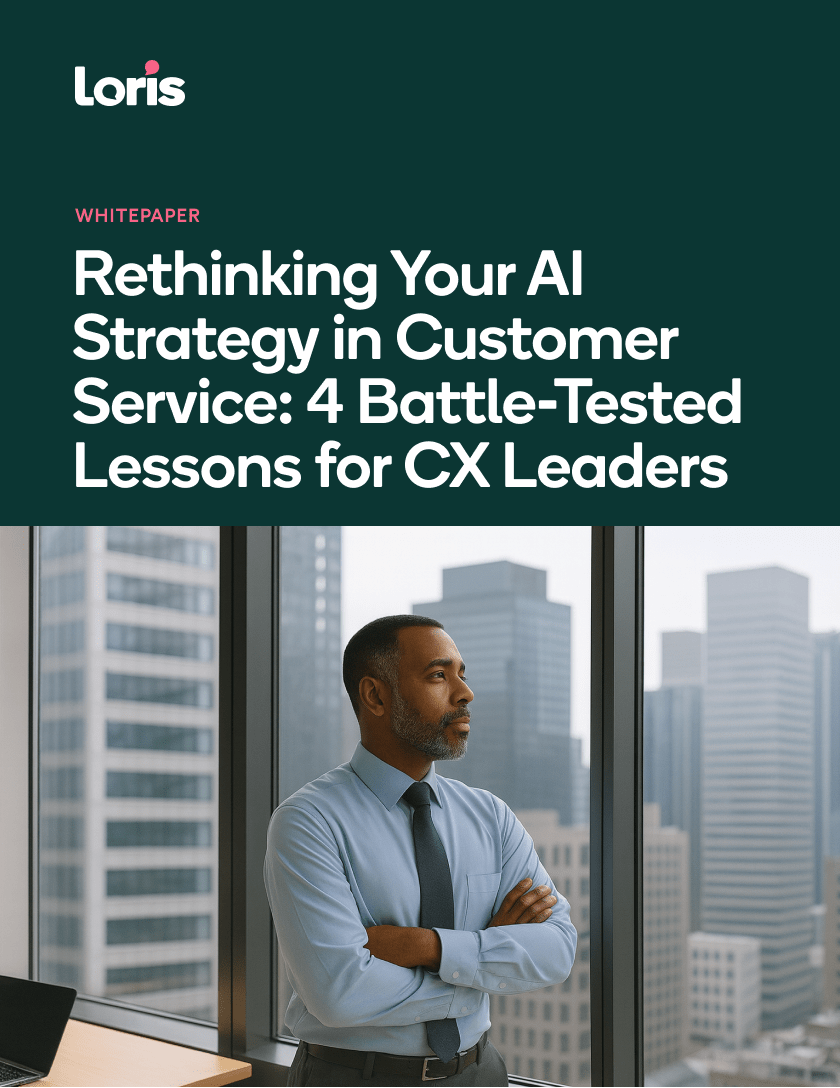
Predictive troubleshooting and AI-driven quality reviews increase call center efficiency while preserving human empathy. Faster onboarding and cultural adaptation through human-AI collaboration sharply enhance customer experience.
- Why Human and AI Collaboration is Reshaping Contact Centers
- Predictive Troubleshooting in Call Center Software
- AI-Driven Quality Reviews for Better Call Center Teams
- Faster Onboarding Through Human-AI Collaboration
- Meeting Global Nuances Head-On
- Data-Focused CX Strategies That Reduce Costs and Grow Loyalty
- Blending Loris Insights With Genuine Human Connection
Why Human and AI Collaboration is Reshaping Contact Centers
The integration of AI in the contact center is driven by a growing demand for rapid responses and deeper insights. This technology can parse massive amounts of customer interactions, detect patterns, and highlight emerging issues long before they impact large numbers of customers. But there’s a critical need to focus on what AI should do, not just what it can do. This perspective keeps human agents at the heart of customer conversations and leverages their empathy, cultural awareness, and creativity.
Now, organizations are starting to adopt a more measured blend of Human and AI collaboration. Solutions that help spot friction points early and improve agent quality with objective data, so they can resolve issues faster without losing that important personal touch.
This emphasis on combining AI’s efficiency with the empathy of live agents aligns with findings in the future of customer service is AI-human collaboration. In practice, many contact centers in industries like retail and financial services want faster issue resolution but refuse to sacrifice genuine, human-driven care. By treating AI as an augmentative force, rather than as a full replacement, contact centers can elevate customer satisfaction and secure loyalty in a way that purely automated services rarely achieve.
AI for Predictive Troubleshooting

Problem
Customer service agents spend too much time on repetitive tasks instead of tackling more valuable customer interactions. In fact, 69% of service professionals report getting bogged down by administrative duties, leaving less energy for complex issues. This is a huge setback for call centers, especially in competitive sectors like telecom, retail, or financial services, where even minor glitches can escalate fast. When problems go unnoticed—like a sudden surge in returned merchandise or unexpected billing errors—customers lose patience, churn risk climbs, and agent morale takes a hit.
Solution
This is where predictive analytics steps in to save time, money, and nerves. AI-driven tools look at past calls, transaction data, and customer records to spot early warning signs—think repeated complaints about a specific payment error or frequent returns of a new product line. With these insights, customer service leaders can work with other teams in the organization to prioritize and resolve the problem before it erupts into a full-blown crisis. CX analysts and agents become proactive strategists, spotting obstacles and stepping in at key moments to offer expert guidance. This balance of AI insights and human empathy is important for modern call centers, as the synergy between service agents and AI is now considered critical to delivering both efficiency and that personal touch.
Key Figures on Efficiency and Customer Experience
Metric | Percentage
|
Service pros spending time on administrative tasks | 69% |
Consumers valuing customer service experience | 43% |
Consumers preferring fewer touchpoints | 60% |
Predictive analytics works behind the scenes to cut down repetitive workloads though human agents handle the nuanced conversations that build real connections. That means happier customers, faster resolutions, and fewer frantic escalations for everyone involved.
Human and AI Collaboration on Quality

The Challenge
Traditional quality assessments for call centers often rely on small, random call samples and manual reviews. Agents might only get feedback once a month—if they’re lucky—leaving huge blind spots in performance. Without consistent, data-driven analysis, it’s easy to miss recurring patterns or agents who need targeted support. This approach can feel slow and clunky, especially in retail or financial services where every conversation can make or break trust.
A Quick Comparison
Traditional Manual Reviews | AI-Powered Quality Intelligence
|
Random sampling reveals only a fraction of calls | Monitors 100% of interactions in real time |
Subjective scoring varies by reviewer | AI-powered metrics offer consistent measurements |
Calls revisited days or weeks later | Faster analysis and ongoing performance trends |
Hard to spot large-scale issues quickly | Identifies patterns and training gaps across teams |
The Hybrid Solution
By integrating automated analysis with human insight, call center leaders can address performance issues swiftly and preserve empathy and context. This full-spectrum approach uncovers nuanced coaching needs, elevates service consistency, and raises morale. Agents receive more balanced and actionable feedback.
Human involvement is still important. AI can flag issues, but experienced team leaders still interpret the data, provide personalized coaching, and rally the emotional support agents need. This union of AI-driven efficiency and genuine human care creates a complete quality assessment system. It’s especially critical in sectors such as finance, where empathetic handling of sensitive data is key for customer trust. And with 54% of consumers expecting better technology experiences within three years, according to recent findings, there’s more pressure than ever to raise the bar on both technology and the human touch.
Faster Agents Through Human and AI Collaboration

Problem: Overwhelming Training Demands
Bringing a new agent onboard in a call center often feels like a marathon. Traditional onboarding involves endless hours of role-play, side-by-side listening, and repetitive tasks that tie up senior team members, creating bottlenecks and slowing real productivity. According to Salesforce, 69% of service professionals spend their time on administrative work, cutting into their capacity for personalized coaching. In high-speed industries such as retail or financial services, this lag can be especially damaging—customers expect agents who are ready from day one.
Solution: Step-by-Step Agent Efficiency
Step 1: AI-Powered Summarization
Rather than having agents take notes on every interaction, AI can summarize the key points. This has the potential to reduce after call work by 20%.
Step 2: AI-Powered Intent Tagging
Similar to summarization, AI can automatically analyze interactions to categorize the issue as well as derive the root cause. Organizations like Calendly have seen significant reductions in cost per call with these strategies.
Step 3: Focus on Complex Calls
With AI agent taking on routine issues and rapid-fire questions, agents will focus more on the true curveballs. They will be there for the chats and calls that require a personal touch, guiding customers especially when AI Agents get stuck in a loop or aren’t trained to handle issues with nuance.
Step 4: Continuous Skill Refinement
AI interaction analytics give managers what they need to tailor agent coaching. AI spots quality issues and deviations from agent performance benchmarks, allowing trainers to modify and improve onboarding materials. The outcome? More confident agents building customer loyalty right away.
Human and AI Collaboration to Meet Global Nuance Head-On

Problem
Call center managers in global companies often stumble when they overlook cultural context. Whether it’s a retail call center in Asia or a financial services helpdesk in Europe, language patterns and local customs vary widely. Automated translation tools can smooth out basic communication, but they frequently miss subtle regional phrases or cultural nuances. This leads to misunderstandings and frustration—even when customers are conversing with an AI Agent in their own language. The challenge is staying on top of rapidly changing dialects, capturing the right meaning, and making sure every conversation feels personal and genuine.
Solution
Providing an AI Agent that converses in the customer’s native language is step 1. But providing culturally aware human agents as backup when AI doesn’t quite get the message creates the right balance. AI excels at quickly detecting language and regional patterns, so for common use cases, it can respond promptly. The human element brings empathy, adapting the approach when a script doesn’t quite fit local customs. For instance, if AI is struggling to understand slang, a culturally trained agent can step in and save the conversation on the fly. This approach not only resolves issues faster but builds authentic connections that customers remember.
Industry Insights
Mathew Garner, a co-founder of a leading customer experience consultancy, points out that letting AI handle the “ordinary” frees up people to handle the “extraordinary.” In practice, that means your automated system deals with routine translations, and your human agents handle escalations that require deeper cultural understanding. According to a Forbes analysis, such synergy vaults satisfaction scores higher, since it shows customers you’re tuned in to their regional and cultural nuances.
Key Indicators of Success
Metric | Value
|
Customers who prefer human agents over chatbots (global avg.) | 43% |
Increase in Net Promoter Score (NPS) with human-led support | +72 pts |
Employees believing AI fosters new skill development | 76% |
These figures suggest that though technology is important for scaling multilingual support, human empathy is still king. In a world where cultural adaptation matters, your call center strategy should do more than just speak the language—it should speak the culture.
Data-Focused Strategies That Reduce Costs and Grow Loyalty

Why Data Matters for Cost Savings and Customer Loyalty
Data-driven strategies help call center teams find issues, adjust agent workloads, and build trust. Here’s a quick look at how analytics leads to stronger decisions:
Strategy | Impact
|
Monitor customer contact volumes | Early detection of spikes reduces long wait times, cutting expenses and improving experience |
Use AI-driven sentiment analysis | Quick reactions to negative sentiment to remedy issues and increase customer loyalty |
Adopt predictive analytics for efficiency | 63% of service professionals see faster service, reducing support costs |
Personalize offers by customer segment | Custom plans for high-value customers improve retention and lifetime value |
Pair insights with automation | Potential $80 billion reduction in agent labor costs by 2026, with a 30% boost in efficiency |
This powerful blend of data and AI brings real savings and keeps customers around. Staying alert to emerging trends and acting on them early gives call centers a long-term edge in both profits and quality service.
Blending Loris Insights With Genuine Human Connection

On a windy Tuesday morning, Kai—a newly promoted manager at a rapidly growing retail call center—stepped onto the busy floor. Rows of agents greeted him, each juggling customers’ questions about late deliveries, payment snafus, and order updates. The entire scene hinted that efficiency alone wouldn’t cut it; empathy would be just as key.
The Unexpected Connection
Kai noticed some customers preferred faster resolutions through chatbots, but nearly 80% still sought a human touch for urgent or personal issues. He remembered reading about a global scheduling platform that saved 23% on support costs yet maintained strong customer bonds. Their secret? A blend of AI-driven insights and well-trained agents.
The Power of Advanced Analytics
Curious, Kai explored how Loris merges advanced analytics with genuine human connection. By using Loris Customer Insights to analyze conversations, his team could flag emerging problems before they escalated. This synergy cut down on repetitive tasks and freed agents to focus on complex questions—where emotional intelligence truly matters.
Merging Empathy With Action
Tapping into Loris QA guided Kai’s quality checks without tedious scorecards. Instead of random reviews, the platform provided targeted feedback, improving agent performance in areas that needed the most attention. He was thrilled to see that developing genuine human touches didn’t mean sacrificing speed; in fact, the right balance made customers feel heard and valued.
Charting the Future
Kai’s experience proved that wisdom lies in balancing automation with true understanding. Customers want quick answers, but they crave empathy, especially in uncertain times. By blending advanced analytics with a personal approach, contact centers can reduce overhead and still leave customers feeling genuinely cared for. In the long run, those who master both—like Kai—will shape the next generation of call center software, where data-driven insights and human connection go hand in hand.
